Challenges and Solutions: Education in the Modern World Report
VerifiedAdded on 2022/12/09
|11
|3520
|369
Report
AI Summary
This report delves into the evolving landscape of modern education, particularly within the higher education sector, examining the impact of technology and its associated challenges. The report identifies key issues such as the integration of technology, professional development for staff, and the need for robust infrastructure and data security. It analyzes the influence of these issues on educational institutions, staff members, and students, highlighting the benefits of technology such as enhanced access to resources and improved student engagement, while also addressing concerns like potential distractions and the digital divide. Furthermore, the report proposes solutions to mitigate these challenges, emphasizing the importance of training, infrastructure upgrades, and adapting teaching methodologies to harness the power of technology effectively. The report concludes by underscoring the need for a proactive approach to ensure that education remains relevant and effective in a rapidly changing world.
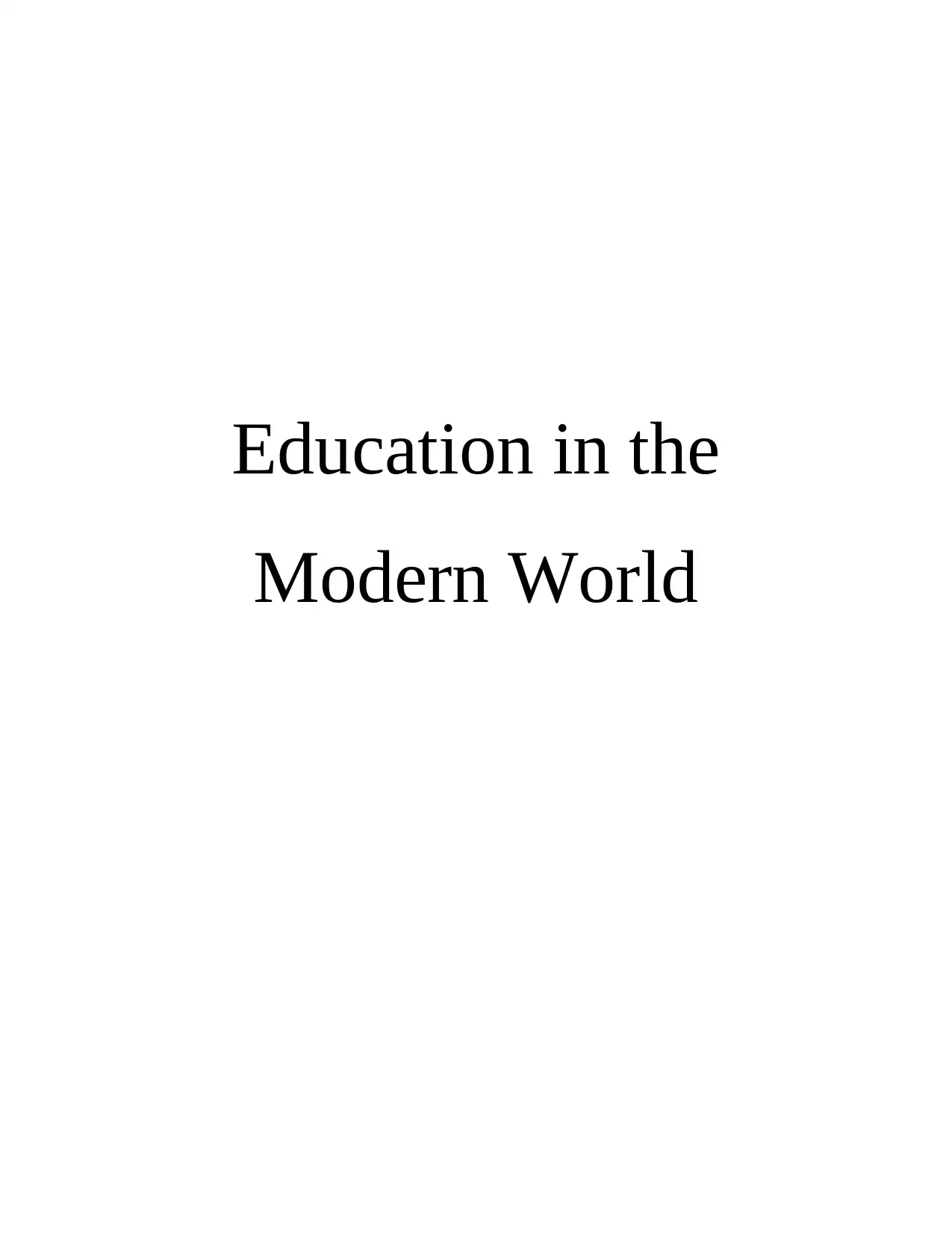
Education in the
Modern World
Modern World
Paraphrase This Document
Need a fresh take? Get an instant paraphrase of this document with our AI Paraphraser
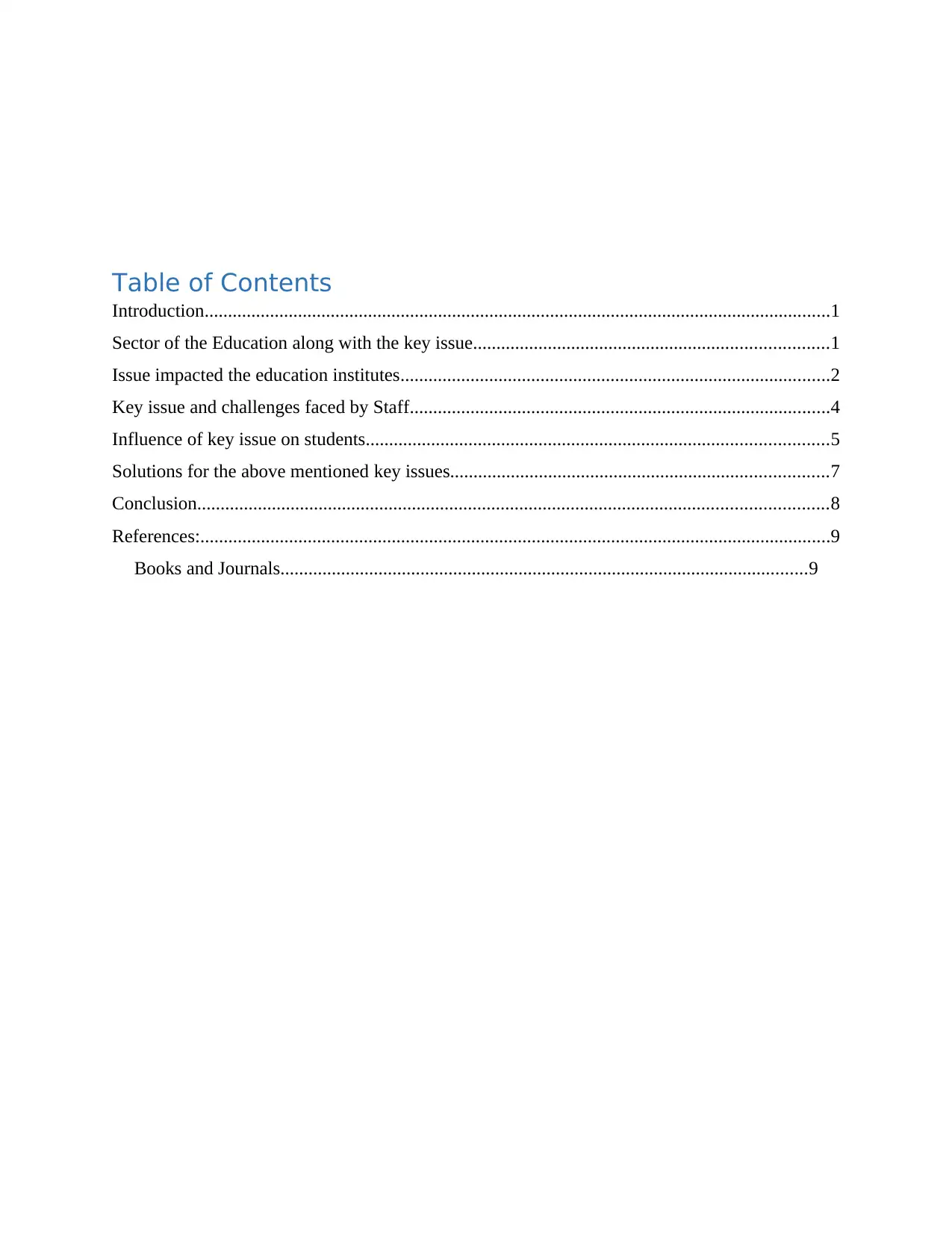
Table of Contents
Introduction......................................................................................................................................1
Sector of the Education along with the key issue............................................................................1
Issue impacted the education institutes............................................................................................2
Key issue and challenges faced by Staff..........................................................................................4
Influence of key issue on students...................................................................................................5
Solutions for the above mentioned key issues.................................................................................7
Conclusion.......................................................................................................................................8
References:.......................................................................................................................................9
Books and Journals.................................................................................................................9
Introduction......................................................................................................................................1
Sector of the Education along with the key issue............................................................................1
Issue impacted the education institutes............................................................................................2
Key issue and challenges faced by Staff..........................................................................................4
Influence of key issue on students...................................................................................................5
Solutions for the above mentioned key issues.................................................................................7
Conclusion.......................................................................................................................................8
References:.......................................................................................................................................9
Books and Journals.................................................................................................................9
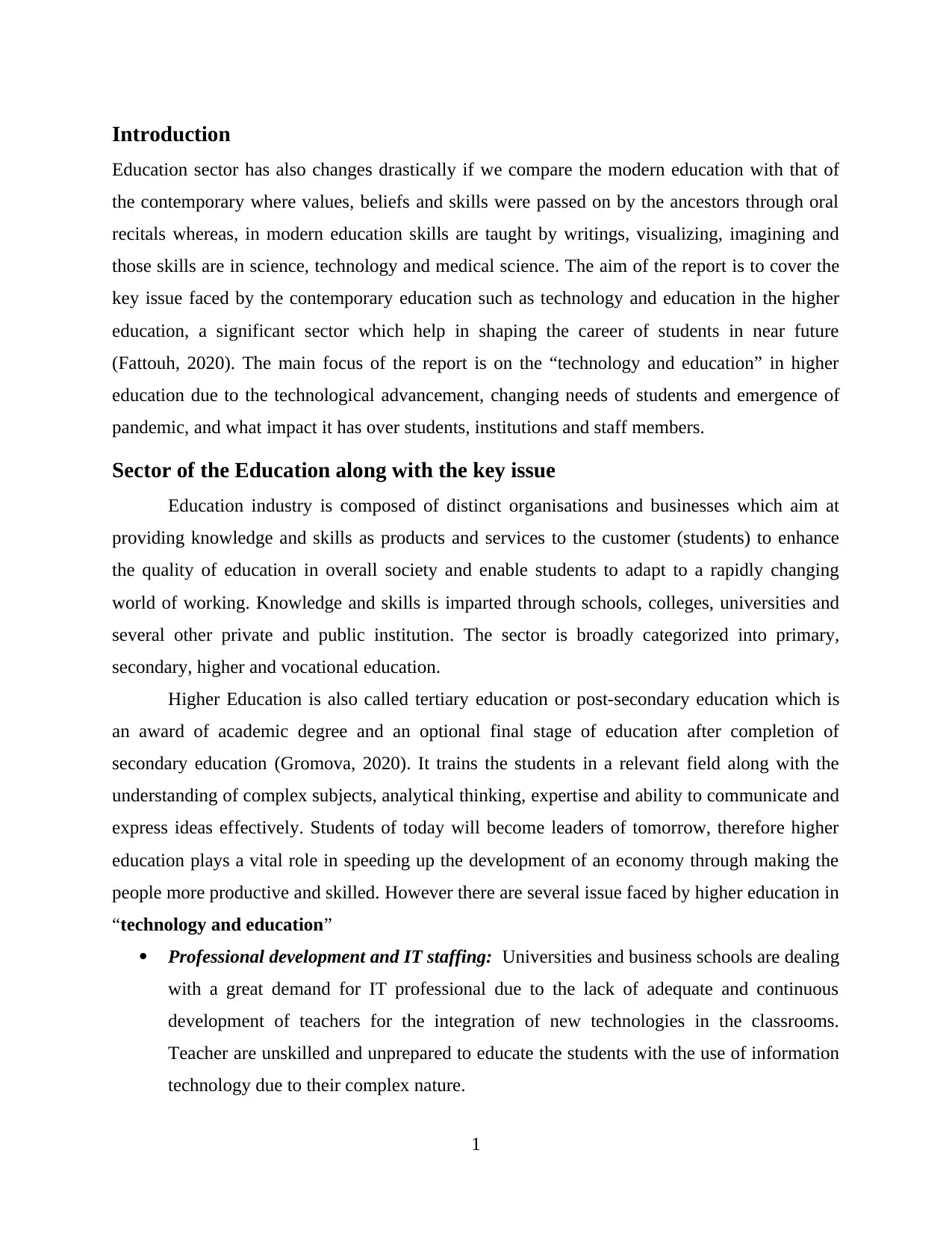
Introduction
Education sector has also changes drastically if we compare the modern education with that of
the contemporary where values, beliefs and skills were passed on by the ancestors through oral
recitals whereas, in modern education skills are taught by writings, visualizing, imagining and
those skills are in science, technology and medical science. The aim of the report is to cover the
key issue faced by the contemporary education such as technology and education in the higher
education, a significant sector which help in shaping the career of students in near future
(Fattouh, 2020). The main focus of the report is on the “technology and education” in higher
education due to the technological advancement, changing needs of students and emergence of
pandemic, and what impact it has over students, institutions and staff members.
Sector of the Education along with the key issue
Education industry is composed of distinct organisations and businesses which aim at
providing knowledge and skills as products and services to the customer (students) to enhance
the quality of education in overall society and enable students to adapt to a rapidly changing
world of working. Knowledge and skills is imparted through schools, colleges, universities and
several other private and public institution. The sector is broadly categorized into primary,
secondary, higher and vocational education.
Higher Education is also called tertiary education or post-secondary education which is
an award of academic degree and an optional final stage of education after completion of
secondary education (Gromova, 2020). It trains the students in a relevant field along with the
understanding of complex subjects, analytical thinking, expertise and ability to communicate and
express ideas effectively. Students of today will become leaders of tomorrow, therefore higher
education plays a vital role in speeding up the development of an economy through making the
people more productive and skilled. However there are several issue faced by higher education in
“technology and education”
Professional development and IT staffing: Universities and business schools are dealing
with a great demand for IT professional due to the lack of adequate and continuous
development of teachers for the integration of new technologies in the classrooms.
Teacher are unskilled and unprepared to educate the students with the use of information
technology due to their complex nature.
1
Education sector has also changes drastically if we compare the modern education with that of
the contemporary where values, beliefs and skills were passed on by the ancestors through oral
recitals whereas, in modern education skills are taught by writings, visualizing, imagining and
those skills are in science, technology and medical science. The aim of the report is to cover the
key issue faced by the contemporary education such as technology and education in the higher
education, a significant sector which help in shaping the career of students in near future
(Fattouh, 2020). The main focus of the report is on the “technology and education” in higher
education due to the technological advancement, changing needs of students and emergence of
pandemic, and what impact it has over students, institutions and staff members.
Sector of the Education along with the key issue
Education industry is composed of distinct organisations and businesses which aim at
providing knowledge and skills as products and services to the customer (students) to enhance
the quality of education in overall society and enable students to adapt to a rapidly changing
world of working. Knowledge and skills is imparted through schools, colleges, universities and
several other private and public institution. The sector is broadly categorized into primary,
secondary, higher and vocational education.
Higher Education is also called tertiary education or post-secondary education which is
an award of academic degree and an optional final stage of education after completion of
secondary education (Gromova, 2020). It trains the students in a relevant field along with the
understanding of complex subjects, analytical thinking, expertise and ability to communicate and
express ideas effectively. Students of today will become leaders of tomorrow, therefore higher
education plays a vital role in speeding up the development of an economy through making the
people more productive and skilled. However there are several issue faced by higher education in
“technology and education”
Professional development and IT staffing: Universities and business schools are dealing
with a great demand for IT professional due to the lack of adequate and continuous
development of teachers for the integration of new technologies in the classrooms.
Teacher are unskilled and unprepared to educate the students with the use of information
technology due to their complex nature.
1
⊘ This is a preview!⊘
Do you want full access?
Subscribe today to unlock all pages.

Trusted by 1+ million students worldwide
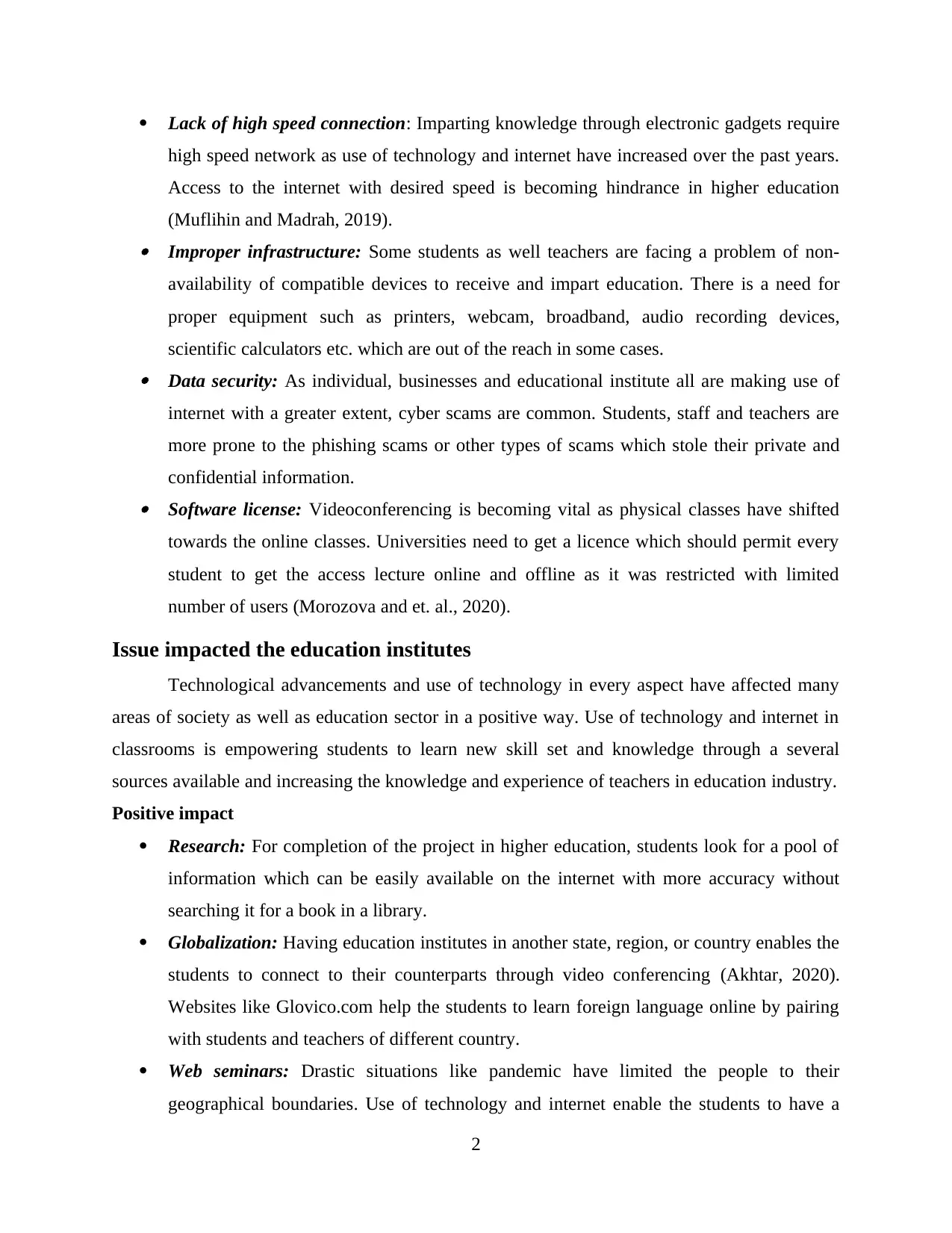
Lack of high speed connection: Imparting knowledge through electronic gadgets require
high speed network as use of technology and internet have increased over the past years.
Access to the internet with desired speed is becoming hindrance in higher education
(Muflihin and Madrah, 2019). Improper infrastructure: Some students as well teachers are facing a problem of non-
availability of compatible devices to receive and impart education. There is a need for
proper equipment such as printers, webcam, broadband, audio recording devices,
scientific calculators etc. which are out of the reach in some cases. Data security: As individual, businesses and educational institute all are making use of
internet with a greater extent, cyber scams are common. Students, staff and teachers are
more prone to the phishing scams or other types of scams which stole their private and
confidential information. Software license: Videoconferencing is becoming vital as physical classes have shifted
towards the online classes. Universities need to get a licence which should permit every
student to get the access lecture online and offline as it was restricted with limited
number of users (Morozova and et. al., 2020).
Issue impacted the education institutes
Technological advancements and use of technology in every aspect have affected many
areas of society as well as education sector in a positive way. Use of technology and internet in
classrooms is empowering students to learn new skill set and knowledge through a several
sources available and increasing the knowledge and experience of teachers in education industry.
Positive impact
Research: For completion of the project in higher education, students look for a pool of
information which can be easily available on the internet with more accuracy without
searching it for a book in a library.
Globalization: Having education institutes in another state, region, or country enables the
students to connect to their counterparts through video conferencing (Akhtar, 2020).
Websites like Glovico.com help the students to learn foreign language online by pairing
with students and teachers of different country.
Web seminars: Drastic situations like pandemic have limited the people to their
geographical boundaries. Use of technology and internet enable the students to have a
2
high speed network as use of technology and internet have increased over the past years.
Access to the internet with desired speed is becoming hindrance in higher education
(Muflihin and Madrah, 2019). Improper infrastructure: Some students as well teachers are facing a problem of non-
availability of compatible devices to receive and impart education. There is a need for
proper equipment such as printers, webcam, broadband, audio recording devices,
scientific calculators etc. which are out of the reach in some cases. Data security: As individual, businesses and educational institute all are making use of
internet with a greater extent, cyber scams are common. Students, staff and teachers are
more prone to the phishing scams or other types of scams which stole their private and
confidential information. Software license: Videoconferencing is becoming vital as physical classes have shifted
towards the online classes. Universities need to get a licence which should permit every
student to get the access lecture online and offline as it was restricted with limited
number of users (Morozova and et. al., 2020).
Issue impacted the education institutes
Technological advancements and use of technology in every aspect have affected many
areas of society as well as education sector in a positive way. Use of technology and internet in
classrooms is empowering students to learn new skill set and knowledge through a several
sources available and increasing the knowledge and experience of teachers in education industry.
Positive impact
Research: For completion of the project in higher education, students look for a pool of
information which can be easily available on the internet with more accuracy without
searching it for a book in a library.
Globalization: Having education institutes in another state, region, or country enables the
students to connect to their counterparts through video conferencing (Akhtar, 2020).
Websites like Glovico.com help the students to learn foreign language online by pairing
with students and teachers of different country.
Web seminars: Drastic situations like pandemic have limited the people to their
geographical boundaries. Use of technology and internet enable the students to have a
2
Paraphrase This Document
Need a fresh take? Get an instant paraphrase of this document with our AI Paraphraser
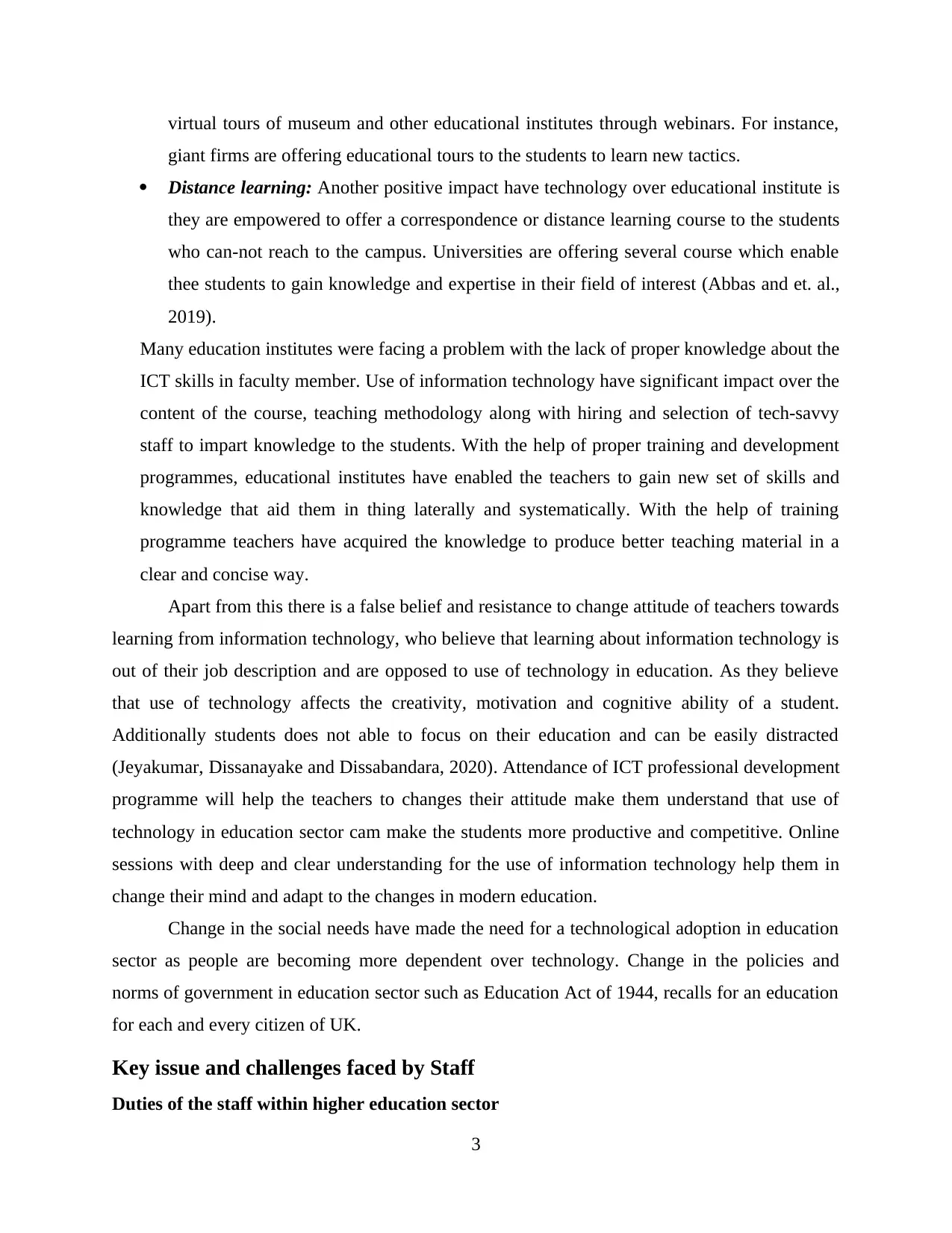
virtual tours of museum and other educational institutes through webinars. For instance,
giant firms are offering educational tours to the students to learn new tactics.
Distance learning: Another positive impact have technology over educational institute is
they are empowered to offer a correspondence or distance learning course to the students
who can-not reach to the campus. Universities are offering several course which enable
thee students to gain knowledge and expertise in their field of interest (Abbas and et. al.,
2019).
Many education institutes were facing a problem with the lack of proper knowledge about the
ICT skills in faculty member. Use of information technology have significant impact over the
content of the course, teaching methodology along with hiring and selection of tech-savvy
staff to impart knowledge to the students. With the help of proper training and development
programmes, educational institutes have enabled the teachers to gain new set of skills and
knowledge that aid them in thing laterally and systematically. With the help of training
programme teachers have acquired the knowledge to produce better teaching material in a
clear and concise way.
Apart from this there is a false belief and resistance to change attitude of teachers towards
learning from information technology, who believe that learning about information technology is
out of their job description and are opposed to use of technology in education. As they believe
that use of technology affects the creativity, motivation and cognitive ability of a student.
Additionally students does not able to focus on their education and can be easily distracted
(Jeyakumar, Dissanayake and Dissabandara, 2020). Attendance of ICT professional development
programme will help the teachers to changes their attitude make them understand that use of
technology in education sector cam make the students more productive and competitive. Online
sessions with deep and clear understanding for the use of information technology help them in
change their mind and adapt to the changes in modern education.
Change in the social needs have made the need for a technological adoption in education
sector as people are becoming more dependent over technology. Change in the policies and
norms of government in education sector such as Education Act of 1944, recalls for an education
for each and every citizen of UK.
Key issue and challenges faced by Staff
Duties of the staff within higher education sector
3
giant firms are offering educational tours to the students to learn new tactics.
Distance learning: Another positive impact have technology over educational institute is
they are empowered to offer a correspondence or distance learning course to the students
who can-not reach to the campus. Universities are offering several course which enable
thee students to gain knowledge and expertise in their field of interest (Abbas and et. al.,
2019).
Many education institutes were facing a problem with the lack of proper knowledge about the
ICT skills in faculty member. Use of information technology have significant impact over the
content of the course, teaching methodology along with hiring and selection of tech-savvy
staff to impart knowledge to the students. With the help of proper training and development
programmes, educational institutes have enabled the teachers to gain new set of skills and
knowledge that aid them in thing laterally and systematically. With the help of training
programme teachers have acquired the knowledge to produce better teaching material in a
clear and concise way.
Apart from this there is a false belief and resistance to change attitude of teachers towards
learning from information technology, who believe that learning about information technology is
out of their job description and are opposed to use of technology in education. As they believe
that use of technology affects the creativity, motivation and cognitive ability of a student.
Additionally students does not able to focus on their education and can be easily distracted
(Jeyakumar, Dissanayake and Dissabandara, 2020). Attendance of ICT professional development
programme will help the teachers to changes their attitude make them understand that use of
technology in education sector cam make the students more productive and competitive. Online
sessions with deep and clear understanding for the use of information technology help them in
change their mind and adapt to the changes in modern education.
Change in the social needs have made the need for a technological adoption in education
sector as people are becoming more dependent over technology. Change in the policies and
norms of government in education sector such as Education Act of 1944, recalls for an education
for each and every citizen of UK.
Key issue and challenges faced by Staff
Duties of the staff within higher education sector
3
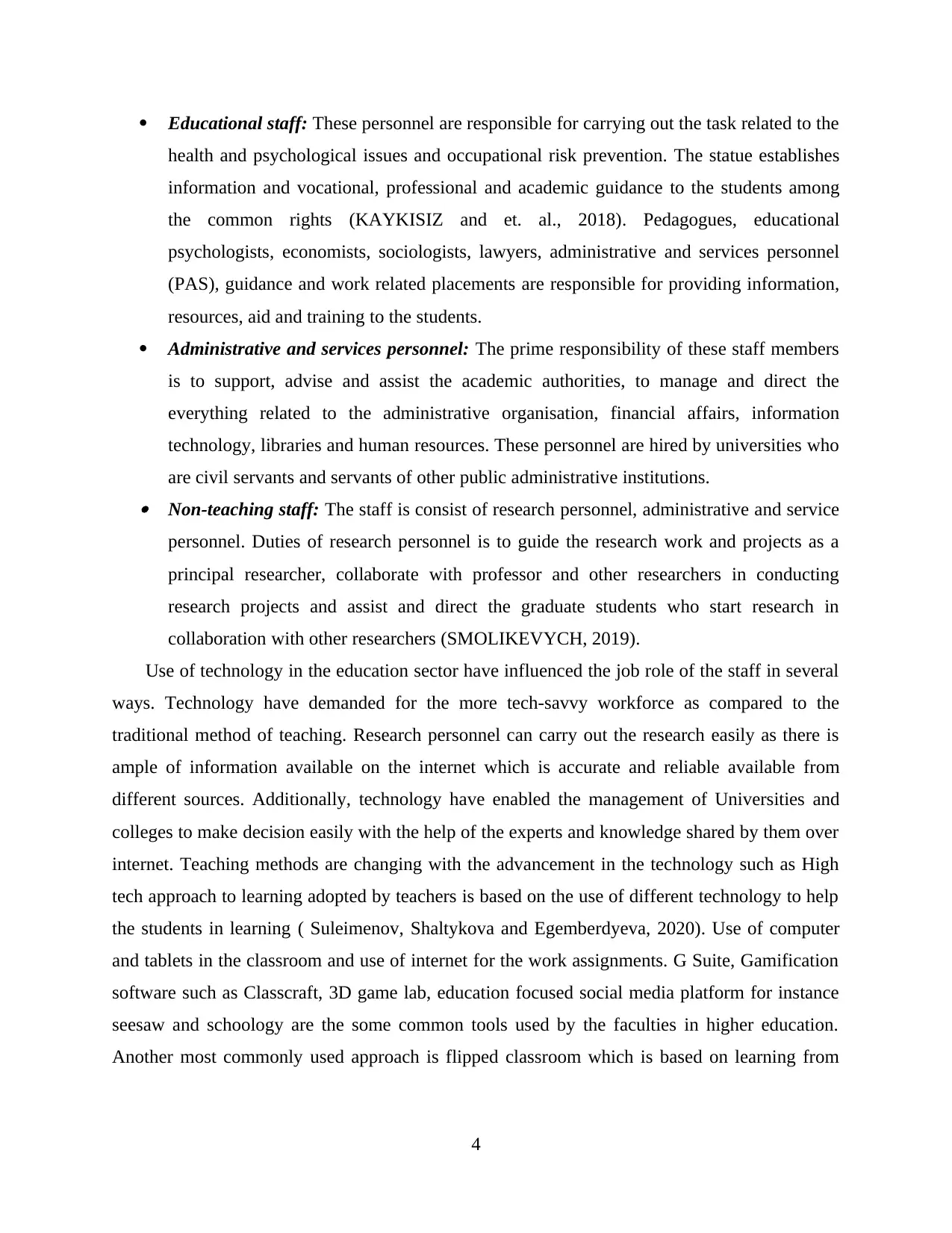
Educational staff: These personnel are responsible for carrying out the task related to the
health and psychological issues and occupational risk prevention. The statue establishes
information and vocational, professional and academic guidance to the students among
the common rights (KAYKISIZ and et. al., 2018). Pedagogues, educational
psychologists, economists, sociologists, lawyers, administrative and services personnel
(PAS), guidance and work related placements are responsible for providing information,
resources, aid and training to the students.
Administrative and services personnel: The prime responsibility of these staff members
is to support, advise and assist the academic authorities, to manage and direct the
everything related to the administrative organisation, financial affairs, information
technology, libraries and human resources. These personnel are hired by universities who
are civil servants and servants of other public administrative institutions. Non-teaching staff: The staff is consist of research personnel, administrative and service
personnel. Duties of research personnel is to guide the research work and projects as a
principal researcher, collaborate with professor and other researchers in conducting
research projects and assist and direct the graduate students who start research in
collaboration with other researchers (SMOLIKEVYCH, 2019).
Use of technology in the education sector have influenced the job role of the staff in several
ways. Technology have demanded for the more tech-savvy workforce as compared to the
traditional method of teaching. Research personnel can carry out the research easily as there is
ample of information available on the internet which is accurate and reliable available from
different sources. Additionally, technology have enabled the management of Universities and
colleges to make decision easily with the help of the experts and knowledge shared by them over
internet. Teaching methods are changing with the advancement in the technology such as High
tech approach to learning adopted by teachers is based on the use of different technology to help
the students in learning ( Suleimenov, Shaltykova and Egemberdyeva, 2020). Use of computer
and tablets in the classroom and use of internet for the work assignments. G Suite, Gamification
software such as Classcraft, 3D game lab, education focused social media platform for instance
seesaw and schoology are the some common tools used by the faculties in higher education.
Another most commonly used approach is flipped classroom which is based on learning from
4
health and psychological issues and occupational risk prevention. The statue establishes
information and vocational, professional and academic guidance to the students among
the common rights (KAYKISIZ and et. al., 2018). Pedagogues, educational
psychologists, economists, sociologists, lawyers, administrative and services personnel
(PAS), guidance and work related placements are responsible for providing information,
resources, aid and training to the students.
Administrative and services personnel: The prime responsibility of these staff members
is to support, advise and assist the academic authorities, to manage and direct the
everything related to the administrative organisation, financial affairs, information
technology, libraries and human resources. These personnel are hired by universities who
are civil servants and servants of other public administrative institutions. Non-teaching staff: The staff is consist of research personnel, administrative and service
personnel. Duties of research personnel is to guide the research work and projects as a
principal researcher, collaborate with professor and other researchers in conducting
research projects and assist and direct the graduate students who start research in
collaboration with other researchers (SMOLIKEVYCH, 2019).
Use of technology in the education sector have influenced the job role of the staff in several
ways. Technology have demanded for the more tech-savvy workforce as compared to the
traditional method of teaching. Research personnel can carry out the research easily as there is
ample of information available on the internet which is accurate and reliable available from
different sources. Additionally, technology have enabled the management of Universities and
colleges to make decision easily with the help of the experts and knowledge shared by them over
internet. Teaching methods are changing with the advancement in the technology such as High
tech approach to learning adopted by teachers is based on the use of different technology to help
the students in learning ( Suleimenov, Shaltykova and Egemberdyeva, 2020). Use of computer
and tablets in the classroom and use of internet for the work assignments. G Suite, Gamification
software such as Classcraft, 3D game lab, education focused social media platform for instance
seesaw and schoology are the some common tools used by the faculties in higher education.
Another most commonly used approach is flipped classroom which is based on learning from
4
⊘ This is a preview!⊘
Do you want full access?
Subscribe today to unlock all pages.

Trusted by 1+ million students worldwide
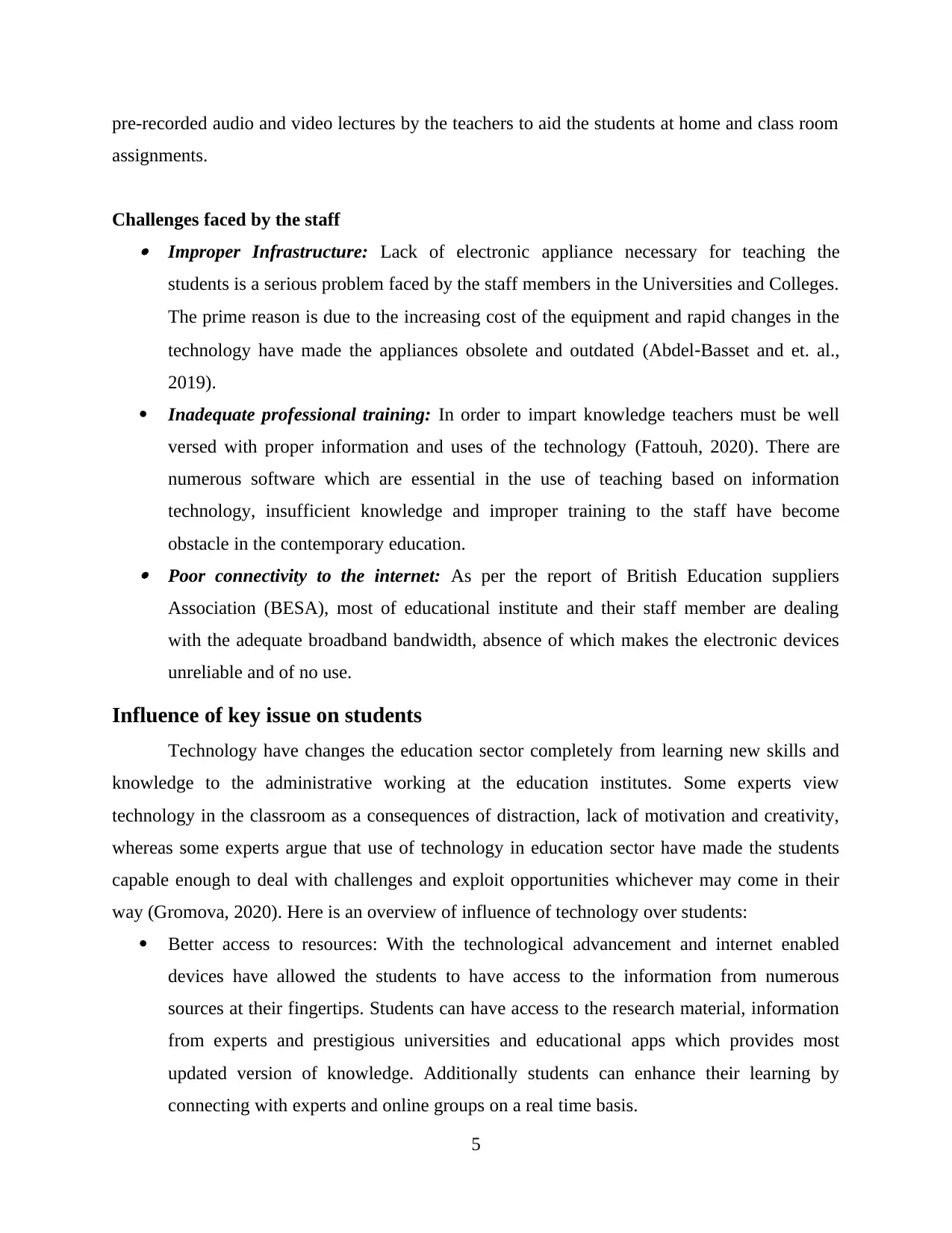
pre-recorded audio and video lectures by the teachers to aid the students at home and class room
assignments.
Challenges faced by the staff Improper Infrastructure: Lack of electronic appliance necessary for teaching the
students is a serious problem faced by the staff members in the Universities and Colleges.
The prime reason is due to the increasing cost of the equipment and rapid changes in the
technology have made the appliances obsolete and outdated (Abdel‐Basset and et. al.,
2019).
Inadequate professional training: In order to impart knowledge teachers must be well
versed with proper information and uses of the technology (Fattouh, 2020). There are
numerous software which are essential in the use of teaching based on information
technology, insufficient knowledge and improper training to the staff have become
obstacle in the contemporary education. Poor connectivity to the internet: As per the report of British Education suppliers
Association (BESA), most of educational institute and their staff member are dealing
with the adequate broadband bandwidth, absence of which makes the electronic devices
unreliable and of no use.
Influence of key issue on students
Technology have changes the education sector completely from learning new skills and
knowledge to the administrative working at the education institutes. Some experts view
technology in the classroom as a consequences of distraction, lack of motivation and creativity,
whereas some experts argue that use of technology in education sector have made the students
capable enough to deal with challenges and exploit opportunities whichever may come in their
way (Gromova, 2020). Here is an overview of influence of technology over students:
Better access to resources: With the technological advancement and internet enabled
devices have allowed the students to have access to the information from numerous
sources at their fingertips. Students can have access to the research material, information
from experts and prestigious universities and educational apps which provides most
updated version of knowledge. Additionally students can enhance their learning by
connecting with experts and online groups on a real time basis.
5
assignments.
Challenges faced by the staff Improper Infrastructure: Lack of electronic appliance necessary for teaching the
students is a serious problem faced by the staff members in the Universities and Colleges.
The prime reason is due to the increasing cost of the equipment and rapid changes in the
technology have made the appliances obsolete and outdated (Abdel‐Basset and et. al.,
2019).
Inadequate professional training: In order to impart knowledge teachers must be well
versed with proper information and uses of the technology (Fattouh, 2020). There are
numerous software which are essential in the use of teaching based on information
technology, insufficient knowledge and improper training to the staff have become
obstacle in the contemporary education. Poor connectivity to the internet: As per the report of British Education suppliers
Association (BESA), most of educational institute and their staff member are dealing
with the adequate broadband bandwidth, absence of which makes the electronic devices
unreliable and of no use.
Influence of key issue on students
Technology have changes the education sector completely from learning new skills and
knowledge to the administrative working at the education institutes. Some experts view
technology in the classroom as a consequences of distraction, lack of motivation and creativity,
whereas some experts argue that use of technology in education sector have made the students
capable enough to deal with challenges and exploit opportunities whichever may come in their
way (Gromova, 2020). Here is an overview of influence of technology over students:
Better access to resources: With the technological advancement and internet enabled
devices have allowed the students to have access to the information from numerous
sources at their fingertips. Students can have access to the research material, information
from experts and prestigious universities and educational apps which provides most
updated version of knowledge. Additionally students can enhance their learning by
connecting with experts and online groups on a real time basis.
5
Paraphrase This Document
Need a fresh take? Get an instant paraphrase of this document with our AI Paraphraser
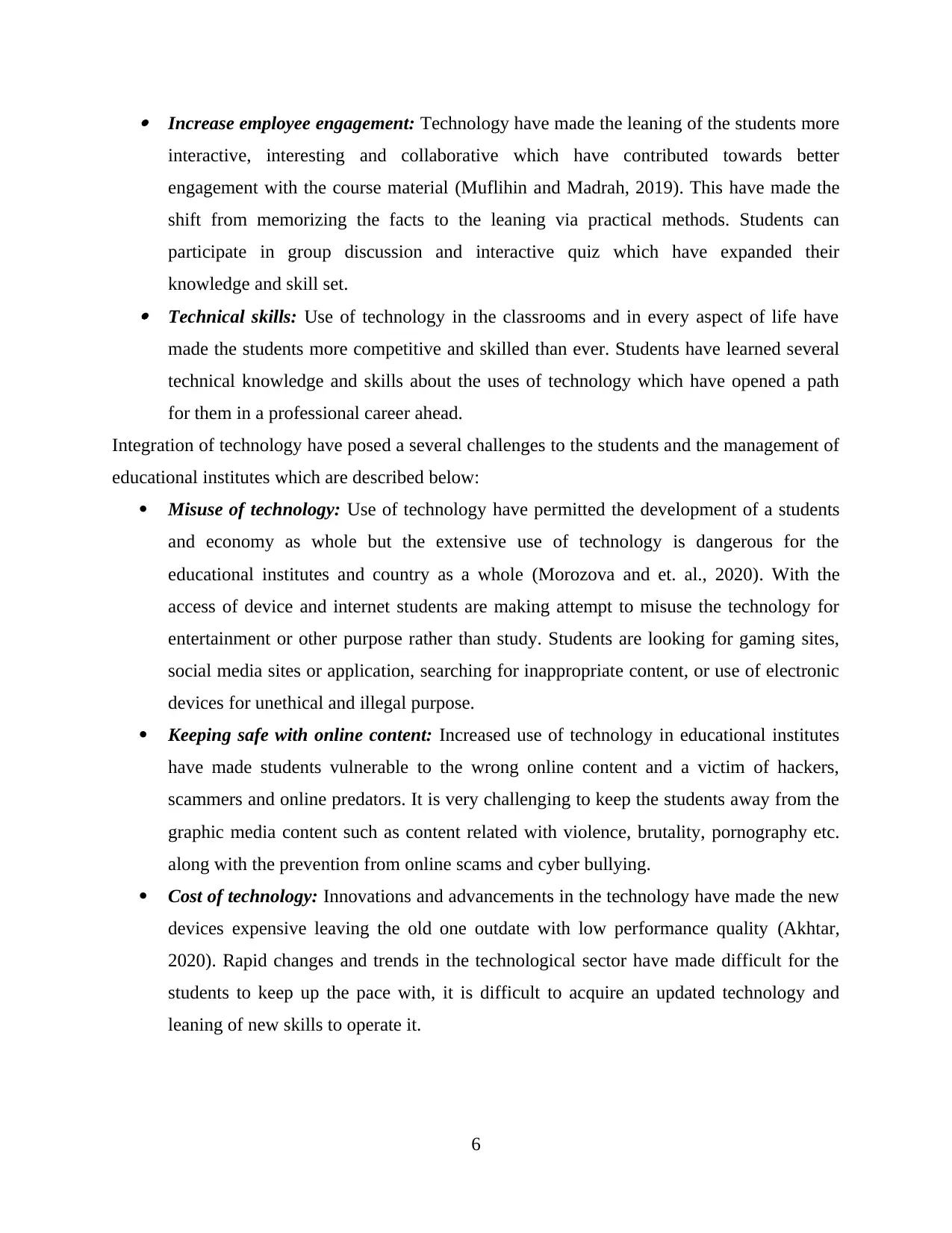
Increase employee engagement: Technology have made the leaning of the students more
interactive, interesting and collaborative which have contributed towards better
engagement with the course material (Muflihin and Madrah, 2019). This have made the
shift from memorizing the facts to the leaning via practical methods. Students can
participate in group discussion and interactive quiz which have expanded their
knowledge and skill set. Technical skills: Use of technology in the classrooms and in every aspect of life have
made the students more competitive and skilled than ever. Students have learned several
technical knowledge and skills about the uses of technology which have opened a path
for them in a professional career ahead.
Integration of technology have posed a several challenges to the students and the management of
educational institutes which are described below:
Misuse of technology: Use of technology have permitted the development of a students
and economy as whole but the extensive use of technology is dangerous for the
educational institutes and country as a whole (Morozova and et. al., 2020). With the
access of device and internet students are making attempt to misuse the technology for
entertainment or other purpose rather than study. Students are looking for gaming sites,
social media sites or application, searching for inappropriate content, or use of electronic
devices for unethical and illegal purpose.
Keeping safe with online content: Increased use of technology in educational institutes
have made students vulnerable to the wrong online content and a victim of hackers,
scammers and online predators. It is very challenging to keep the students away from the
graphic media content such as content related with violence, brutality, pornography etc.
along with the prevention from online scams and cyber bullying.
Cost of technology: Innovations and advancements in the technology have made the new
devices expensive leaving the old one outdate with low performance quality (Akhtar,
2020). Rapid changes and trends in the technological sector have made difficult for the
students to keep up the pace with, it is difficult to acquire an updated technology and
leaning of new skills to operate it.
6
interactive, interesting and collaborative which have contributed towards better
engagement with the course material (Muflihin and Madrah, 2019). This have made the
shift from memorizing the facts to the leaning via practical methods. Students can
participate in group discussion and interactive quiz which have expanded their
knowledge and skill set. Technical skills: Use of technology in the classrooms and in every aspect of life have
made the students more competitive and skilled than ever. Students have learned several
technical knowledge and skills about the uses of technology which have opened a path
for them in a professional career ahead.
Integration of technology have posed a several challenges to the students and the management of
educational institutes which are described below:
Misuse of technology: Use of technology have permitted the development of a students
and economy as whole but the extensive use of technology is dangerous for the
educational institutes and country as a whole (Morozova and et. al., 2020). With the
access of device and internet students are making attempt to misuse the technology for
entertainment or other purpose rather than study. Students are looking for gaming sites,
social media sites or application, searching for inappropriate content, or use of electronic
devices for unethical and illegal purpose.
Keeping safe with online content: Increased use of technology in educational institutes
have made students vulnerable to the wrong online content and a victim of hackers,
scammers and online predators. It is very challenging to keep the students away from the
graphic media content such as content related with violence, brutality, pornography etc.
along with the prevention from online scams and cyber bullying.
Cost of technology: Innovations and advancements in the technology have made the new
devices expensive leaving the old one outdate with low performance quality (Akhtar,
2020). Rapid changes and trends in the technological sector have made difficult for the
students to keep up the pace with, it is difficult to acquire an updated technology and
leaning of new skills to operate it.
6
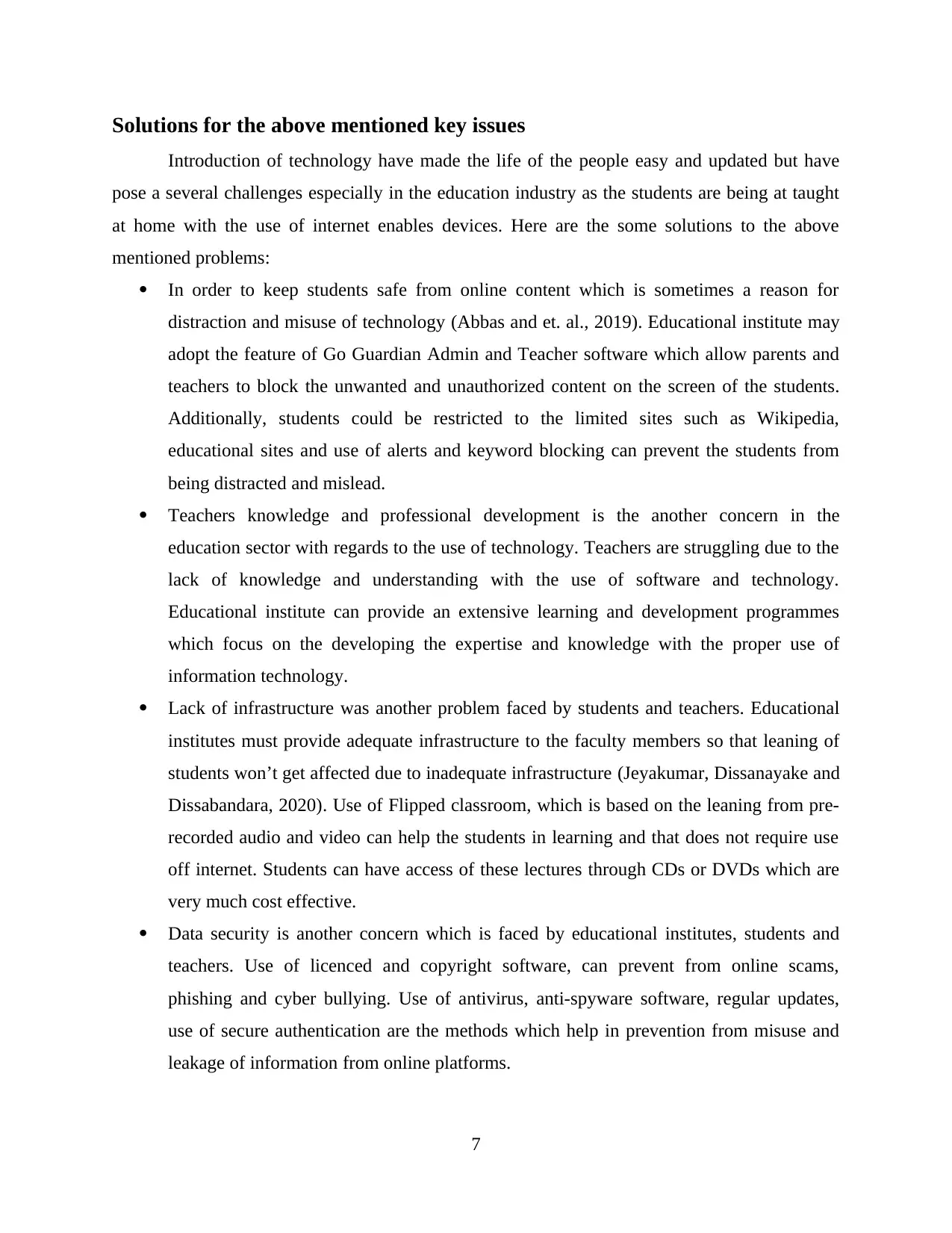
Solutions for the above mentioned key issues
Introduction of technology have made the life of the people easy and updated but have
pose a several challenges especially in the education industry as the students are being at taught
at home with the use of internet enables devices. Here are the some solutions to the above
mentioned problems:
In order to keep students safe from online content which is sometimes a reason for
distraction and misuse of technology (Abbas and et. al., 2019). Educational institute may
adopt the feature of Go Guardian Admin and Teacher software which allow parents and
teachers to block the unwanted and unauthorized content on the screen of the students.
Additionally, students could be restricted to the limited sites such as Wikipedia,
educational sites and use of alerts and keyword blocking can prevent the students from
being distracted and mislead.
Teachers knowledge and professional development is the another concern in the
education sector with regards to the use of technology. Teachers are struggling due to the
lack of knowledge and understanding with the use of software and technology.
Educational institute can provide an extensive learning and development programmes
which focus on the developing the expertise and knowledge with the proper use of
information technology.
Lack of infrastructure was another problem faced by students and teachers. Educational
institutes must provide adequate infrastructure to the faculty members so that leaning of
students won’t get affected due to inadequate infrastructure (Jeyakumar, Dissanayake and
Dissabandara, 2020). Use of Flipped classroom, which is based on the leaning from pre-
recorded audio and video can help the students in learning and that does not require use
off internet. Students can have access of these lectures through CDs or DVDs which are
very much cost effective.
Data security is another concern which is faced by educational institutes, students and
teachers. Use of licenced and copyright software, can prevent from online scams,
phishing and cyber bullying. Use of antivirus, anti-spyware software, regular updates,
use of secure authentication are the methods which help in prevention from misuse and
leakage of information from online platforms.
7
Introduction of technology have made the life of the people easy and updated but have
pose a several challenges especially in the education industry as the students are being at taught
at home with the use of internet enables devices. Here are the some solutions to the above
mentioned problems:
In order to keep students safe from online content which is sometimes a reason for
distraction and misuse of technology (Abbas and et. al., 2019). Educational institute may
adopt the feature of Go Guardian Admin and Teacher software which allow parents and
teachers to block the unwanted and unauthorized content on the screen of the students.
Additionally, students could be restricted to the limited sites such as Wikipedia,
educational sites and use of alerts and keyword blocking can prevent the students from
being distracted and mislead.
Teachers knowledge and professional development is the another concern in the
education sector with regards to the use of technology. Teachers are struggling due to the
lack of knowledge and understanding with the use of software and technology.
Educational institute can provide an extensive learning and development programmes
which focus on the developing the expertise and knowledge with the proper use of
information technology.
Lack of infrastructure was another problem faced by students and teachers. Educational
institutes must provide adequate infrastructure to the faculty members so that leaning of
students won’t get affected due to inadequate infrastructure (Jeyakumar, Dissanayake and
Dissabandara, 2020). Use of Flipped classroom, which is based on the leaning from pre-
recorded audio and video can help the students in learning and that does not require use
off internet. Students can have access of these lectures through CDs or DVDs which are
very much cost effective.
Data security is another concern which is faced by educational institutes, students and
teachers. Use of licenced and copyright software, can prevent from online scams,
phishing and cyber bullying. Use of antivirus, anti-spyware software, regular updates,
use of secure authentication are the methods which help in prevention from misuse and
leakage of information from online platforms.
7
⊘ This is a preview!⊘
Do you want full access?
Subscribe today to unlock all pages.

Trusted by 1+ million students worldwide
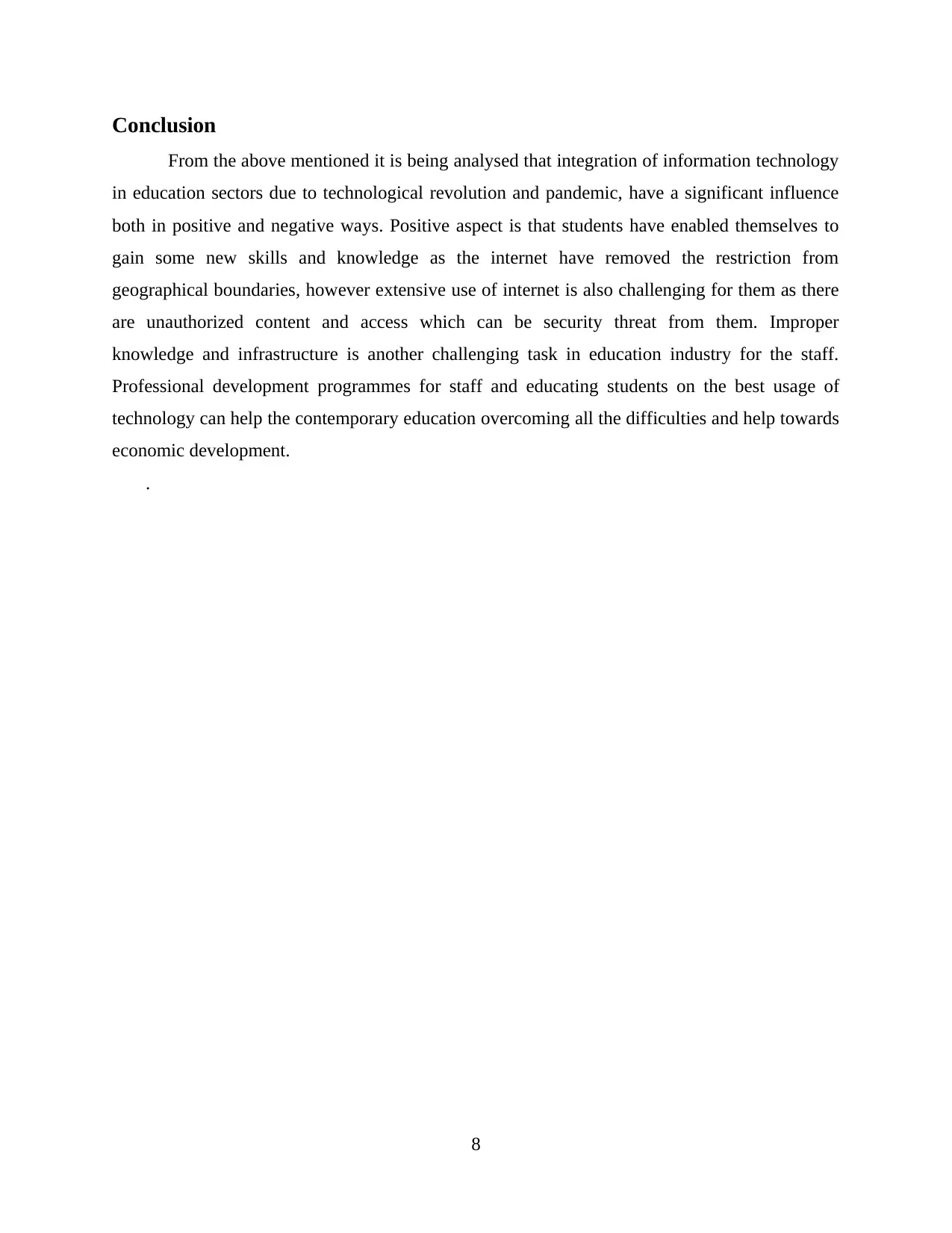
Conclusion
From the above mentioned it is being analysed that integration of information technology
in education sectors due to technological revolution and pandemic, have a significant influence
both in positive and negative ways. Positive aspect is that students have enabled themselves to
gain some new skills and knowledge as the internet have removed the restriction from
geographical boundaries, however extensive use of internet is also challenging for them as there
are unauthorized content and access which can be security threat from them. Improper
knowledge and infrastructure is another challenging task in education industry for the staff.
Professional development programmes for staff and educating students on the best usage of
technology can help the contemporary education overcoming all the difficulties and help towards
economic development.
.
8
From the above mentioned it is being analysed that integration of information technology
in education sectors due to technological revolution and pandemic, have a significant influence
both in positive and negative ways. Positive aspect is that students have enabled themselves to
gain some new skills and knowledge as the internet have removed the restriction from
geographical boundaries, however extensive use of internet is also challenging for them as there
are unauthorized content and access which can be security threat from them. Improper
knowledge and infrastructure is another challenging task in education industry for the staff.
Professional development programmes for staff and educating students on the best usage of
technology can help the contemporary education overcoming all the difficulties and help towards
economic development.
.
8
Paraphrase This Document
Need a fresh take? Get an instant paraphrase of this document with our AI Paraphraser
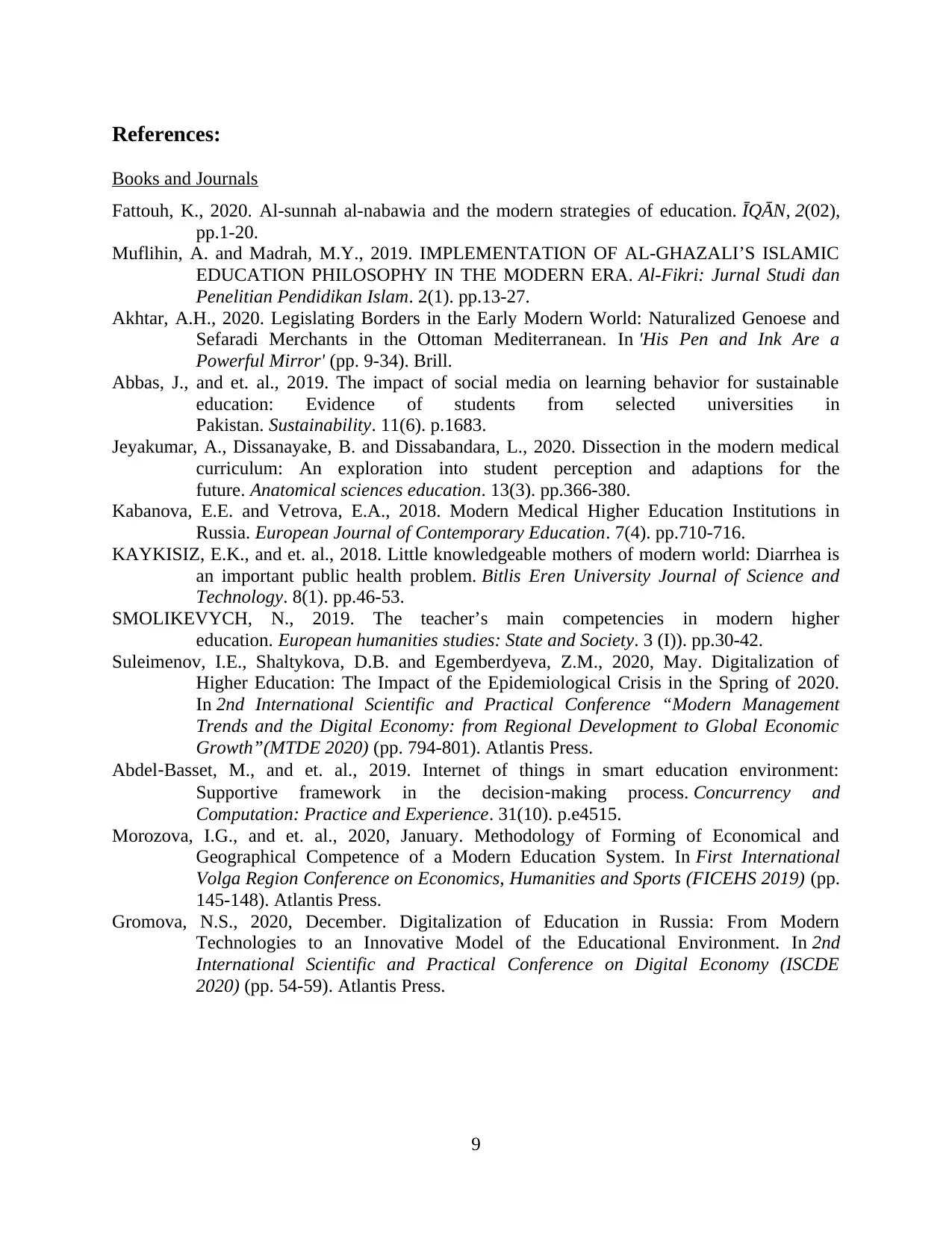
References:
Books and Journals
Fattouh, K., 2020. Al-sunnah al-nabawia and the modern strategies of education. ĪQĀN, 2(02),
pp.1-20.
Muflihin, A. and Madrah, M.Y., 2019. IMPLEMENTATION OF AL-GHAZALI’S ISLAMIC
EDUCATION PHILOSOPHY IN THE MODERN ERA. Al-Fikri: Jurnal Studi dan
Penelitian Pendidikan Islam. 2(1). pp.13-27.
Akhtar, A.H., 2020. Legislating Borders in the Early Modern World: Naturalized Genoese and
Sefaradi Merchants in the Ottoman Mediterranean. In 'His Pen and Ink Are a
Powerful Mirror' (pp. 9-34). Brill.
Abbas, J., and et. al., 2019. The impact of social media on learning behavior for sustainable
education: Evidence of students from selected universities in
Pakistan. Sustainability. 11(6). p.1683.
Jeyakumar, A., Dissanayake, B. and Dissabandara, L., 2020. Dissection in the modern medical
curriculum: An exploration into student perception and adaptions for the
future. Anatomical sciences education. 13(3). pp.366-380.
Kabanova, E.E. and Vetrova, E.A., 2018. Modern Medical Higher Education Institutions in
Russia. European Journal of Contemporary Education. 7(4). pp.710-716.
KAYKISIZ, E.K., and et. al., 2018. Little knowledgeable mothers of modern world: Diarrhea is
an important public health problem. Bitlis Eren University Journal of Science and
Technology. 8(1). pp.46-53.
SMOLIKEVYCH, N., 2019. The teacher’s main competencies in modern higher
education. European humanities studies: State and Society. 3 (I)). pp.30-42.
Suleimenov, I.E., Shaltykova, D.B. and Egemberdyeva, Z.M., 2020, May. Digitalization of
Higher Education: The Impact of the Epidemiological Crisis in the Spring of 2020.
In 2nd International Scientific and Practical Conference “Modern Management
Trends and the Digital Economy: from Regional Development to Global Economic
Growth”(MTDE 2020) (pp. 794-801). Atlantis Press.
Abdel‐Basset, M., and et. al., 2019. Internet of things in smart education environment:
Supportive framework in the decision‐making process. Concurrency and
Computation: Practice and Experience. 31(10). p.e4515.
Morozova, I.G., and et. al., 2020, January. Methodology of Forming of Economical and
Geographical Competence of a Modern Education System. In First International
Volga Region Conference on Economics, Humanities and Sports (FICEHS 2019) (pp.
145-148). Atlantis Press.
Gromova, N.S., 2020, December. Digitalization of Education in Russia: From Modern
Technologies to an Innovative Model of the Educational Environment. In 2nd
International Scientific and Practical Conference on Digital Economy (ISCDE
2020) (pp. 54-59). Atlantis Press.
9
Books and Journals
Fattouh, K., 2020. Al-sunnah al-nabawia and the modern strategies of education. ĪQĀN, 2(02),
pp.1-20.
Muflihin, A. and Madrah, M.Y., 2019. IMPLEMENTATION OF AL-GHAZALI’S ISLAMIC
EDUCATION PHILOSOPHY IN THE MODERN ERA. Al-Fikri: Jurnal Studi dan
Penelitian Pendidikan Islam. 2(1). pp.13-27.
Akhtar, A.H., 2020. Legislating Borders in the Early Modern World: Naturalized Genoese and
Sefaradi Merchants in the Ottoman Mediterranean. In 'His Pen and Ink Are a
Powerful Mirror' (pp. 9-34). Brill.
Abbas, J., and et. al., 2019. The impact of social media on learning behavior for sustainable
education: Evidence of students from selected universities in
Pakistan. Sustainability. 11(6). p.1683.
Jeyakumar, A., Dissanayake, B. and Dissabandara, L., 2020. Dissection in the modern medical
curriculum: An exploration into student perception and adaptions for the
future. Anatomical sciences education. 13(3). pp.366-380.
Kabanova, E.E. and Vetrova, E.A., 2018. Modern Medical Higher Education Institutions in
Russia. European Journal of Contemporary Education. 7(4). pp.710-716.
KAYKISIZ, E.K., and et. al., 2018. Little knowledgeable mothers of modern world: Diarrhea is
an important public health problem. Bitlis Eren University Journal of Science and
Technology. 8(1). pp.46-53.
SMOLIKEVYCH, N., 2019. The teacher’s main competencies in modern higher
education. European humanities studies: State and Society. 3 (I)). pp.30-42.
Suleimenov, I.E., Shaltykova, D.B. and Egemberdyeva, Z.M., 2020, May. Digitalization of
Higher Education: The Impact of the Epidemiological Crisis in the Spring of 2020.
In 2nd International Scientific and Practical Conference “Modern Management
Trends and the Digital Economy: from Regional Development to Global Economic
Growth”(MTDE 2020) (pp. 794-801). Atlantis Press.
Abdel‐Basset, M., and et. al., 2019. Internet of things in smart education environment:
Supportive framework in the decision‐making process. Concurrency and
Computation: Practice and Experience. 31(10). p.e4515.
Morozova, I.G., and et. al., 2020, January. Methodology of Forming of Economical and
Geographical Competence of a Modern Education System. In First International
Volga Region Conference on Economics, Humanities and Sports (FICEHS 2019) (pp.
145-148). Atlantis Press.
Gromova, N.S., 2020, December. Digitalization of Education in Russia: From Modern
Technologies to an Innovative Model of the Educational Environment. In 2nd
International Scientific and Practical Conference on Digital Economy (ISCDE
2020) (pp. 54-59). Atlantis Press.
9
1 out of 11
Related Documents
Your All-in-One AI-Powered Toolkit for Academic Success.
+13062052269
info@desklib.com
Available 24*7 on WhatsApp / Email
![[object Object]](/_next/static/media/star-bottom.7253800d.svg)
Unlock your academic potential
Copyright © 2020–2025 A2Z Services. All Rights Reserved. Developed and managed by ZUCOL.





